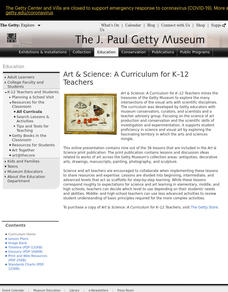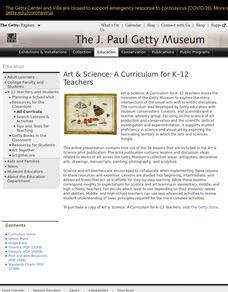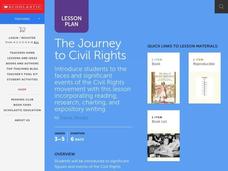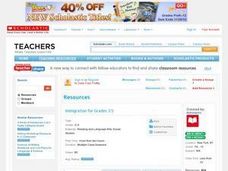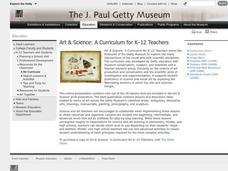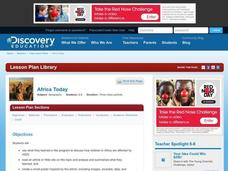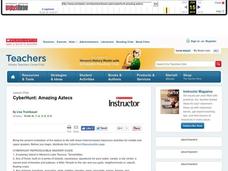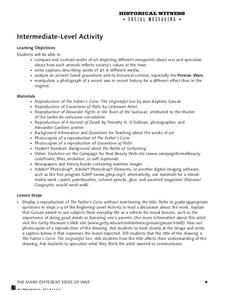Curated OER
Constellation Companions
Students research the star composition for a constellation after a brainstorming session suggesting why humans have organized the night sky into constellation patterns. They use the research to create their own constellation and myth...
Curated OER
Historical Witness: Social Messaging
Students examine the persuasive techniques of leaders. In this propaganda lesson, students discover the practices that Louis XIV and Caligula used to persuade others. Students watch "The Merchants of Cool" and discuss propaganda used...
Curated OER
Clearly Classified
Learners investigate plants and insects. In this science classification lesson plan, young scholars create separate categories for insects and plants by characteristics. Learners discover scientific names of insects.
Curated OER
Constellation Companions
Learners identify constellations and the characteristics of the stars that compose them. For this space science lesson, students view depictions of Ursa Major and Ursa Minor in the book Astronomical Micelleny. Learners create their own...
Curated OER
The Journey to Civil Rights
Young scholars investigate the concepts that surround the Civil Rights Movement. They conduct research with the help of the teacher and use chart paper to create posters about major people involved. Students also complete a timeline...
Curated OER
The Facts on Nuclear Power
Students browse a Web site to gather information about nuclear power. They explain how nuclear power is generated and used.
Curated OER
Lincoln Meets Gates
Students research historical figures and create presentations for their research using technology tools. For this historical figures lesson, students use the provided links to research historical figures in America. Students then use...
Curated OER
Discovering Your Community
Students focus on the origins of the families that make up their community by exploring their family's origins through themselves, parents, and grandparents. Students create a map marked with family origins for the class.
Curated OER
It Looked Like Spilt Milk
Class rereads book It Looked Like Spilt Milk and reviews what a good sentence looks like. They look at websites which contain cloud pictures and then use their imagination and draw on the computer their cloud pictures.
Curated OER
Author's Corner
Second graders read a picture book at a Web site about a bunny who solves a problem and becomes friends with a squirrel. Students then discuss story with classmates, brainstorm ideas for their own stories about friendship, and read the...
Curated OER
Immigration For Grades 3-5
Students engage in a lesson that is concerned with the concept of immigration. They conduct research using a variety of resources. Students create a KWL chart to organize the information. The lesson also includes a resource link for the...
Curated OER
Medieval Natural Resources
Students discuss and view examples of the illuminated manuscripts that were created during medieval times and into the Renaissance. In small groups, they research the resources that were used to create the manuscripts and classify them...
Curated OER
Finding Balance
Learners explore how an artist uses the force of gravity to create balance in a sculpture. In this sculpting lesson, students create their own sculpture applying concepts from the lesson.
Curated OER
From My Point of View
Second graders read a story from an online picture book. After reading the story, they pretend to be Gilbert, one of the main characters and create a narrative to accompany the illustrations. They compare their narrative with that of...
Curated OER
Africa Today
Students examine the AIDS crisis in Africa. In this global studies lesson, students watch "Medical Crisis in Africa," and read articles about AIDS in Africa. Students then research the topic and create awareness posters.
Curated OER
Lesson Plan #2- Phases of the Moon
Students create phases of the moon out of white paper plates. Students utilize the created phases of the moon to practice sight identification. A classroom competition is held in order to determine who is best at identifying the phases...
Curated OER
Amazing Aztecs
Students research information about the ancient Aztec culture. In this Aztec lesson, students conduct Internet research about Aztecs to find the answers to questions about their language, jewelry and tools, and the Aztec calendar. ...
Curated OER
Historical Witness Social Messaging Beginning Level Activity
Young scholars explore women in history. In this activity about nineteenth century women, students analyze paintings looking at women and their clothing, expressions, body language, and the setting and color. Young scholars understand...
Curated OER
The Energy Equation
Students explore human energy components. In this personal health lesson plan, students determine how food, sleep, and exercise impact human energy levels as they play BAM! Body and Mind interactive games. Students create motivational...
Curated OER
Safe Driving
Students explore the implications of teen driving. In this personal health lesson, students research and discuss impaired driving, seat belt usage, speeding, and distracted driving. Students then create public awareness marketing...
Curated OER
Number Base
Eighth graders examine common number system bases that are used: decimal, binary, octa and hex. They create a presentation about one of the number systems using the internet to research the topic. They solve mathematical computations.
Curated OER
You Can Depend on Me
Students identify how they depend on others, and examine and discuss the images on the California Quarter Reverse. They view and discuss images of various habitats, complete a Habitat Research worksheet, and create a habitat diorama.
Curated OER
Historical Witness: Social Messaging
Students complete activities to study the propaganda elements from various war times. In this war propaganda lesson plan, students compare and contrast works of art from various viewpoints about war from varying social periods. Students...
Curated OER
Immigration Explorations
Students visit John Schick's Virtual Ellis Island Museum in order to complete research and evaluate how students created their site, how they structured the site, and what sort of information and graphics they included. This list is...




